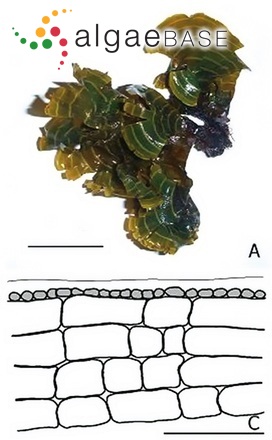Taonia abbottiana D.S.Littler & Littler 2004

Current name:
Taonia abbottiana D.S.Littler & Littler
recolectada en una cresta arrecifal, en la zona Nororiental: a. espécimen herborizado; b. células medulares de la zona basal en sección longitudinal. Foto: Yusimí Alfonso. Esquema: Mayrene Guimarais.
Publication Details
Taonia abbottiana D.S.Littler & Littler 2004: 420, figs 1-7
Published in: Littler, D.S. & Littler, M.M. (2004). Taonia abbottiana sp. nov. (Dictyotales, Phaeophyceae) from the Tropical Western Atlantic. Cryptogamie Algologie 25(4): 419-427, 8 figs, 1 table.
Type Species
The type species (holotype) of the genus Taonia is Taonia atomaria (Woodward) J.Agardh.
Status of Name
This name is of an entity that is currently accepted taxonomically.
Type Information
Type locality: 2 miles W of Discovery Bay (18º29.071'N 77º30.154'W), Jamaica; (Littler & Littler 2004: 424) Holotype: D.S. Littler, M.M. Littler, B.L. Brooks and S.A. Reed (#D & M Littler-51849); 2 June 1996; Growing in a mixed community on hard substrate, 10-20 m deep; US Alg. Coll.; 208962 (Littler & Littler 2004: 424)
General Environment
This is a marine species.
Description
The thallus appears as an erect cluster of iridescent yellow-brown, fan-shaped blades growing up to 20cm high. Blades may reach up to 15 cm wide, and are 180-210 microns thick. Older blades can split and become ragged and somewhat strap-shaped. The margins are smooth, but often become irregular due to uneven growth or splitting. Distinct light-colored concentric lines are formed by narrow bands of surface hairs, easily observed in living material; but when pressed and air-dried, the light bands turn dark and thus this feature does not aid in identification. These lines of surface hairs are approximately 1-3 mm apart near the margins, and 6-8 mm apart near the base; thus, the surface hair lines become progressively further apart as the blade matures, and in older blades may occasionally form isolated, short, irregular lines rather than the smooth concentric lines found in younger portions of the blade. In longitudinal section,the medulla consists of two layers of cells in younger tissue, within 2mm of the growing margin, and four medullary layers in older areas, beyond 4 mm from the growing margin. Cells of the medulla are roughly square in transverse section and generally rectangular in longitudinal section, ranging from 50-125 microns in length, 30-60 microns in thickness, and arranged in irregular rows. Surface cells are irregularly rectangular in surface view, growing to 15 microns in width, 20 microns in length and 20-30 microns in thickness. Surface hairs occur in transverse narrow bands, alternating irregularly from ventral to dorsal side of the blade; however, they are most commonly found on the dorsal side of the blade. Sporangial sori closely border and run parallel to the hair bands and are generally most abundant on the ventral side of the blade. However, these sori occur intermittently and are not always present. The sporangia are spherical to oval, 80-100 microns in diameter, and are formed on a short, two-celled stalk up to 30 microns in diameter, which elevates the sporangium proper well above the surface of the blade.
Habitat
On rock or coral fragments in sandy areas or on solid substrates; up to 40 m deep, most commonly occurring less than 15 m deep.
Created: 16 March 2007 by G.M. Guiry.
Last updated: 28 September 2023
Verification of Data
Users are responsible for verifying the accuracy of information before use, as noted on the website Content page.
Linking to this page: https://www.algaebase.org/search/species/detail/?species_id=132173
Citing AlgaeBase
Cite this record as:
M.D. Guiry in Guiry, M.D. & Guiry, G.M. 28 September 2023. AlgaeBase. World-wide electronic publication, National University of Ireland, Galway. https://www.algaebase.org; searched on 10 June 2025















